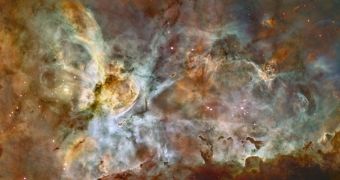More than eighteen years after it was launched into space, the Hubble Space Telescope is still the spearhead of our space exploration program, systematically mapping and bringing new and wondrous insight into what we call home, our universe. Recently, the Walters Art Museum has organized an exposition named "Maps: Finding Our Place in the World," featuring 20 of Hubble's most beautiful pictures of our universe until now.
The organization of the unique exhibit was done by scientists from the Space Telescope Science Institute and Professor Elizabeth Rodini and her students, who had the role of choosing the images and designing the two rooms specially allocated for the exhibit. The STScI scientists had the express job of selecting the images for the Palazzo Courtyard and handling the images for the Manuscripts Gallery.
Professor Rodini: "The Hopkins students had to work through some very complicated idea, even beyond the basic of astronomy, in order to come up with an installation that was scientifically informed but also appropriate to an art museum." Also, they seemed to work very well as a team, thus collaborating with various professionals to create the finished product that would be displayed in the gallery.
Rarely had the pictures taken by Hubble the unique opportunity to be displayed amongst art museum, especially with the help of the public. The biggest picture put on display in the Walters Art Museum is 3 meters wide and was chosen mostly for its visual impact on the viewer, revealing the true beauties of the universe and creating a link between aesthetics and science at the same time.
Senior image processor at the STScI, Zoltan Levay says that he is truly grateful to see the pictures made by Hubble from science data among the beautiful art in the Walters Art Museum, and hopes that the visitors will enjoy the pictures of the cosmic landscape.
The students brought up by Professor Rodini first had to study the basics of curating, then participated in a presentation made by the STScI, featuring the science production of images based on the data provided by Hubble. Once the pictures were chosen, they presented a cardboard model of how the gallery should appear. The STScI team responded instantly by creating a 3D model of the cardboard, one to show the students how the finished exhibition gallery would look like.
Amongst the pictures chosen for the exhibition were images of the Carina and Eagle Nebula, or the Tadpole galaxies.

 14 DAY TRIAL //
14 DAY TRIAL //